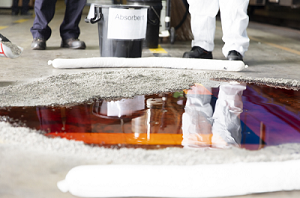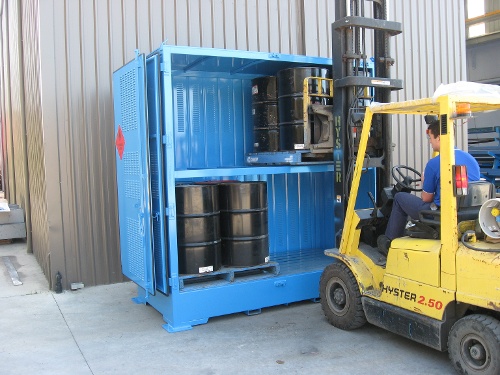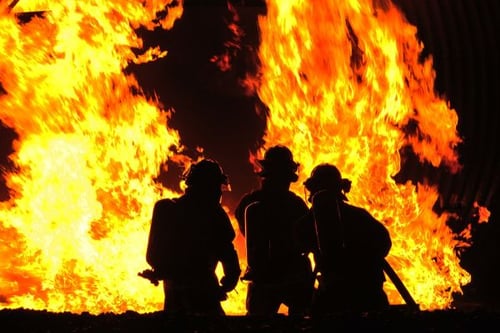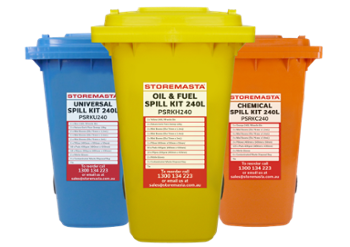Are you meeting your compliance obligations for chemical spill kits? If your business is carrying hazardous chemicals, it’s important that you’re fully prepared to tackle a chemical spill clean-up. But what are the regulations and requirements that apply to spill kits in Australia? In this blog, we’ll be looking at the legal obligations that apply to chemical spill management. We’ll also be highlighting the key spill kit requirements for flammable liquids, toxic substances and corrosive chemicals.
WHS Regulations For Spill Management
When do you require a spill kit? The answer is relatively simple — and stated in Model Work Health and Safety (WHS) Regulations.
Your workplace will require a spill kit if there is any risk of a hazardous chemical (solid or liquid form) spill or leak. This includes spills or leaks that may occur in any area of your orgnisation that uses, handles, generates or stores hazardous chemicals.
Section 357 of WHS Regulations explains that workplaces must make sure that the spill containment system allows for the effective clean-up (and disposal) of hazardous chemical spills or leaks, as well as any resulting effluent.
While your spill containment system (ie. bunded storage, floor bunding, bunded trolleys etc) works to prevent and minimise chemical spills, your spill kit is the tool which will help your staff clean-up the spill — and safely dispose of the chemical waste and resulting effluent.

As part of your legal obligations, you must provide a spill kit for the clean-up and disposal of hazardous chemical spills and leaks.
What Items Are Needed In A Spill Kit?
The spill kit will be a range of materials (compatible with the chemical class that you’re carrying) to aid the clean-up and waste removal of the chemical leak or spill.
Items found in spill kits may include:
- Absorbent materials – to mop up and stop the chemical spill
- Chemical containers – to house the contents of split chemical packages
- Bins or large containers with lids – to place spilled chemical
- Chemical waste bags – to contain any resulting effluent
- Clean-up tools – such as brooms or shovels
- Personal Protective Equipment (PPE) – to protect staff who are tending to the spill
Items found in a spill kit will include absorbents, chemical containers, waste bags, tools for the clean-up and PPE.
Choosing Chemical Spill Kits
While there are a range of spill kits on the market, it’s important that you choose a kit that’s applicable for the type of chemical that your business is carrying. Some materials and substances can react with certain classes of dangerous goods, which can result in further hazards – and put you at risk of non-compliance.
You must also choose a spill kit that provides the required capacity to clean-up your hazardous chemical spill. Spill kits come in a range of sizes and can be customised to suit the needs of your organisation. You may also have to also add further items to your kit (such as extra items for absorption including pads, loose absorbents, sand or fuller’s earth clay) to meet your specific chemical clean-up requirements.
How Many Spill Kits Do You Require?
Don’t be mistaken in thinking that a single spill kit is enough to protect your business from chemical spills.
Understanding the types of chemicals that you have at your site — as well as the quantities — is an important step in determining your spill kit requirements.
It’s not as straightforward as buying one or two general purpose spill kits — and then assuming you’re properly prepared to handle a chemical spill. The amount of spill kits that you need will be determined by the chemicals carried in your workplace. It will also depend on the layout of your organisation and how many spill kits will be required for each specific work area.

Make sure your spill kits are located in any area of your workplace that carries or stores hazardous chemicals.
When positioning spill kits, you must make sure that they are within easy reach of workers in the event of an accidental leak or spill. Making workers search for spill kits or travel long distances to obtain one will only increase the risks associated with the hazardous chemical spill.
Consider how many areas of your business could be affected if a chemical spill could occur. There are probably many more locations that require a spill kit that you may have originally thought. In addition to this, consider the countless ways in which a spill could occur. And keep in mind that spills can occur far beyond your dangerous goods storage areas.
Conduct a risk assessment that reviews every part of your workplace that may come into contact will hazardous chemicals. This includes delivery docks, decanting or pumping areas, and any part of your organisation that uses (or transfers) hazardous chemical products.
Unless you’re carrying only a very small quantity of hazardous chemicals, a couple of spill kits will probably not be sufficient when managing a chemical spill. For organisations that store dangerous goods in larger quantities, there is an even greater risk of chemical hazards, such as fire, asphyxiation, property damage or environmental contamination.
Therefore, through a detailed risk assessment of your workplace, you should be able to determine the type and quantity of spill kits that you will require. However, if you want to learn more about the specific details of spill kit contents and placement, then it’s important that you understand the requirements that apply to spill kits for each class of dangerous goods.
What Are The Requirements For Having Spill Kits Onsite?
While the requirements for your spill kits are detailed in the relevant Australian Standard, we’ve compiled a short list of requirements that relate to the most used classes of chemicals including flammable liquids, toxic substances and corrosive chemicals.
Flammable Liquid Spill Kit Requirements
The requirements for Class 3 Flammable Liquids are covered in the Australian Standard AS 1940 – The storage and handling of flammable and combustible liquids.
In Section 2.3.4 Spill Control, the Standard explains that:
All spills and leaks shall be cleaned up immediately. Any waste shall be disposed of safely and in accordance with the local regulations. Liquids shall not be allowed to reach ignition sources, stores of other chemicals, or combustible materials (e.g. timber and paper), or flow into drains or onto neighbouring land, or enter any creek, pond or waterway.
The Standard explains that a basic flammable liquids spill response kit should include the following items:
- Absorbent pads or loose absorbent
- Booms – on ground and floating
- Drain covers and plugs
- Loose absorbent
- Contaminated waste bags
- Portable pumps and decanting equipment
- Yard brooms
- Shovels
- Personal protective equipment (refer to the SDS of your liquids)
This should all be packed in a clearly marked weather resistant container that is made from a material compatible with the flammable liquids that will be cleaned up during the spill response.

Flammable liquid spill clean-ups must be managed to reduce the risk of flashback, fire and explosion.
When preparing for and cleaning up a flammable liquids spill, remember that even small quantities can create a vapour cloud which can travel considerable distances through the workplace. This vapour cloud could meet with an ignition source, and cause flashback, fire or an explosion.
Quickly controlling the flammable liquids spill, as well as the hazardous vapours that are emitted from it, is crucial in maintaining safety during the clean-up (and waste disposal) process. You can reduce risk by ensuring that areas are well-ventilated and there are no ignition sources present during the clean-up process.
Toxic Substances Spill Kit Requirements
Due to the toxic nature of this chemical class, a trained and equipped team of two or more staff should be assigned to the decontamination, clean-up and investigation of a leak or spill. No entry into the affected area should be made unless under the supervision of a responsible worker.
AS NZS 4452 – The storage and handling of toxic substances explains that clean-up materials and equipment should be appropriate for the spilled substance and not cause a reaction. For every toxic substance leak or spill, the emergency plan must be implemented, and emergency services should be notified if a dangerous situation arises.
Toxic substance spill kits should include:
- Neutralising and decontaminating chemicals
- Absorbent materials
- Calcium hydroxide (acidic or pesticide spills), sodium bisulfate (alkaline spills)
- Sodium carbonate
- Crushed calcium carbonate
- Approved and labelled containers to repackage leaking toxic substances
- Portable pumps and decanting equipment
- Yard broom
- Shovels
- Personal protective equipment (refer to the SDS of your toxic substances)
Corrosive Substances Spill Kit Requirements
Class 8 chemicals can destroy living tissue, as well as degrade materials such as wood or metal. Therefore, when dealing with a corrosive substance spills in your workplace, you need to make sure that people and property are completely protected during the clean-up process.
AS 3780 - The storage and handling of corrosive substances details the spill kit requirements for this class of chemicals.
Section 7.5.2 Clean-Up Materials and Equipment provides a list of items required for corrosive substance spill kits:
- Neutralising and decontaminating chemicals
- Absorbent materials such as sand, fuller’s earth or suitable substances
- Calcium hydroxide (acidic spills), sodium bisulfate (alkaline spills)
- Crushed calcium carbonate
- Compatible and labelled waste-recovery containers for emergency use only
- Approved and labelled containers to repackage leaking corrosive substances
- Personal protective equipment (refer to the SDS of your liquids)
- Portable pumps and decanting equipment
- Shovels
Even if your organisation has a small leak or spill or corrosive substances, it’s important that the spilled chemical does not react with materials once it’s disposed of. Therefore, you should place the absorbent used in the clean-up process in a waste container for safe disposal.
Is Your Spill Kit Compliant?
As part of your obligations under WHS Regulations, your organisation must provide a spill kit if your business handles, uses, generates or stores any type or quantity of hazardous chemicals. By understanding your requirements, as per the relevant Australian Standard, you can help keep your organisation safe and meet your compliance obligations.
To learn more about improving chemical safety in your workplace, why not access your free Spill Kit Checkilst? Our handy downloadable will help you stay on top of your spill kit obligations. Get yours for free now.
Joining the team as a Dangerous Goods Storage Consultant, Melissa Hampton became Storemasta's Marketing Manager in late 2021. With extensive knowledge and experience in chemical compliance, Melissa is responsible for leading the Marketing team and helping shape their marketing strategy. In her spare time, you can find Melissa hiking, swimming and enjoying the great outdoors in beautiful north-west Tasmania.

